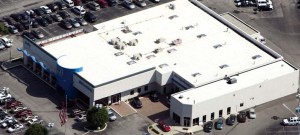A California Win-Win: White Roofs
Advice from East Bay Roofing Professionals

California takes cool roofing seriously. The state’s energy code mandates standards of roof energy efficiency, including how well the roof reflects light (its reflectance) and how much heat it gives off (its emittance). Taken together, reflectance and emittance give a material’s solar reflectance index, or SRI. Since 2005, Title 24 Building Energy Efficiency Standards have required all roofing materials to be labeled with ratings certified by the Cool Roof Rating Council. Roofing contractors must use materials that meet reflectance and emittance standards.
White roofs go beyond the minimum requirements to provide the highest reflectance and the lowest emittance. Government-rated ENERGY STAR products can lower roof temperatures by up to 100°F and reduce midday cooling demand by 10–15 percent. White roof painting, the simplest way to whiten a roof, is gaining in popularity. And of all the states in the continental U.S., California stands out as the place where a white roof makes the most sense. Only Hawaii stands to save as much from switching to white roofing.
Higher energy costs in California and Hawaii account for part of the difference. Also, California and Hawaii experience very little “penalty” for a white roof in winter. Northern and interior states benefit from the heat retention of a dark roof in winter; for them, there may be no net advantage from a white roof. Here in California, savings are at the upper end of the scale, up to $1.72 per square meter of roof, according to the Heat Island Group at Lawrence Berkeley Labs.
Benefits Beyond Money
With white roofing, any air-conditioned building will save on costs; a building without air conditioning will become more comfortable. But benefits extend beyond the building and its operating costs. The energy saved translates to lower emissions from fossil-fuel power plants, so air quality is improved. When enough urban cooling measures are put in place, air quality is further improved by reduction of ground-level ozone. Ozone, the primary component of smog, forms more quickly at higher temperatures.
The Urban Heat Island effect is the modern name for a phenomenon that has been observed for generations; replacement of vegetation with paving and buildings results in higher temperatures in built-up areas, and urban centers, with the most buildings and the greatest added power use, are the hottest of all. A city can feel like an oven in summer, and air conditioning to fight the heat indoors puts a strain on the energy grid at peak hours, sometimes leading to outages. White roofs, along with greening and other measures, can increase comfort in the urban environment, lowering ambient temperatures by several degrees while helping to avoid overtaxing the power grid.
How It’s Done for Bay Area Roofing
A cooler roof can be achieved at re-roofing time by substituting materials with a superior solar reflectance index. But there is no need to wait until your roof is old. A simple solution that can be applied at any time is a special reflective white coating that reflects up to 90 percent of sunlight, half of which is infrared. Contact the expert roofing repair and roofing installers at Century Roof and Solar today at (888) 233-7548 about what we can do to brighten your roof and help you realize energy savings quickly, without disruption to your business or home.
